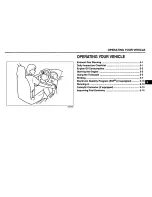
Cooling System Pressure Cap
The cap must be fully tightened to prevent loss of engine
coolant (antifreeze), and to ensure that engine coolant
(antifreeze) will return to the radiator from the coolant
recovery tank.
The cap should be inspected and cleaned if there is any
accumulation of foreign material on the sealing surfaces.
The image on the coolant system pres-
sure cap is a reminder that the radiator
contains hot engine coolant under
pressure.
WARNING!
•
Do not open hot engine cooling system. Never add
engine coolant (antifreeze) when the engine is
overheated. Do not loosen or remove the cap to cool
an overheated engine. Heat causes pressure to
build up in the cooling system. To prevent scalding
or injury, do not remove the pressure cap while the
system is hot or under pressure.
•
Do not use a pressure cap other than the one
specified for your vehicle. Personal injury or en-
gine damage may result.
Disposal Of Used Engine Coolant
Used ethylene glycol-based engine coolant (antifreeze) is
a regulated substance requiring proper disposal. Check
with your local authorities to determine the disposal
rules for your community. To prevent ingestion by ani-
mals or children, do not store ethylene glycol-based
7
MAINTAINING YOUR VEHICLE
347
Summary of Contents for 2015 ProMaster City
Page 4: ...I n f o r ma t i o nP r o v i d e db y...
Page 7: ...1 INTRODUCTION 5 I n f o r ma t i o nP r o v i d e db y...
Page 10: ...I n f o r ma t i o nP r o v i d e db y...
Page 196: ...I n f o r ma t i o nP r o v i d e db y...
Page 242: ...240 STARTING AND OPERATING I n f o r ma t i o nP r o v i d e db y...
Page 380: ...I n f o r ma t i o nP r o v i d e db y...
Page 397: ...INDEX 10 I n f o r ma t i o nP r o v i d e db y...
Page 414: ...15VM 126 AC Third Edition Printed in U S A FCA US LLC I n f o r ma t i o nP r o v i d e db y...
















































